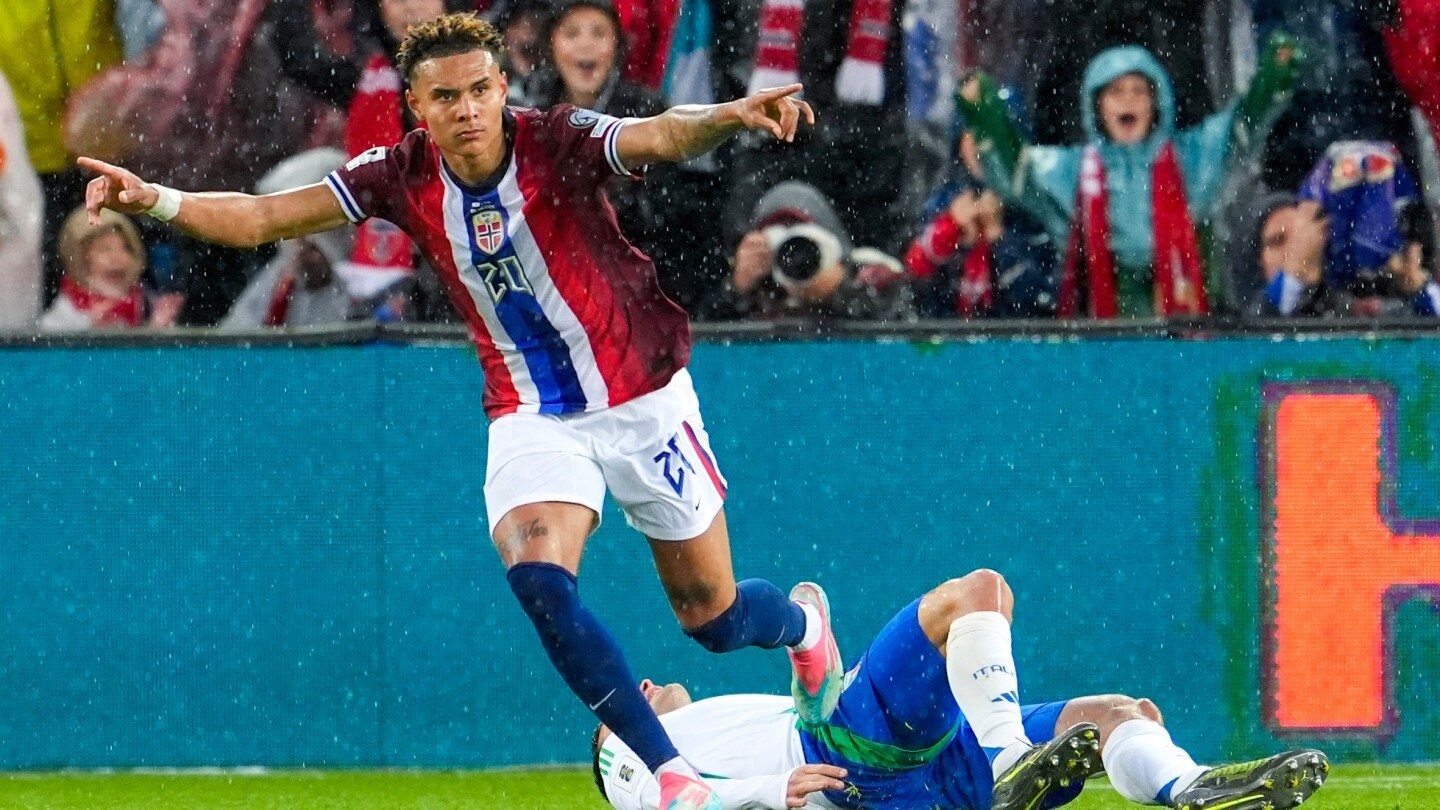"World-class" Norway: youth training + staying abroad, there is no shortcut to rise

Written by Han Bing The last time Norway reached the finals of a major tournament (Euro 2000), Britney's single was still at the top of the Billboard charts; Sony has just released the PS2, can you imagine how far away it is now? In the past 25 years, Norwegian football has experienced the slow elimination of the era of globalization, and through the national model of youth training, greatly improving the opportunities of young players in the league, and encouraging young players to stay abroad, the "three-pronged" strategy, perseverance, and finally "resurrection" ushered in a full-scale outbreak.
For Norwegian football now, most people only see Haaland and Odegaard who are too dazzling. However, it is easy to ignore the other newcomers who have benefited from the "Football 2020" plan formulated by the Norwegian Football Association in 2015, such as Noosa, Szjedrup, Bob, Wolfy, Peterson, Larsson, and Östigaard. And unlike most Norwegian players in the 1990s who sought to develop in the English league, this Norwegian team has a main team in the five major leagues, and the technical and tactical experience obtained is more diversified, so Norwegian football has become more technical and diverse.
Like other small football countries that have made rapid progress in recent years, improving the youth training system + encouraging foreign retention is the fundamental reason why Norwegian football has bottomed out. There are no shortcuts to the rise of Norwegian football.
Comprehensive youth training, ten years to achieve
Since 2005, the decline of Rosenborg, the dominant player in the Norwegian league, has significantly reduced the pool of youth talent. As a result, Norway's youth training system, which basically relied on clubs to cultivate talents, has suffered a major blow. In 2017, Norway lost to weak Northern Ireland and Azerbaijan in World Cup qualifiers, and their world ranking fell to an all-time low (88th). Although the Norwegian Football Association began to increase its investment in youth training in 2015, the fiasco decided to invest more money in a major youth strategy called "Football 2020".
The Norwegian Football Association has established a national football academy, the first football academy classification system was implemented in 2017, and 12 national youth training centers have been established in major cities such as Oslo and Bergen. There are more than 200 youth football centres in the community, covering 67% of the tertiary administrative areas. In the latest version of the 2025-2030 development strategy, this coverage ratio should reach 85%. At the same time, local youth training centers and club-owned youth training have established an all-age echelon from U9 to U19, aiming to expand the youth football population as much as possible. The strategy for 2025-2030 calls for 470,000 football members, or 8% of Norway's population. A 10 per cent increase in the number of children aged 6-12 who start playing football, while halving the rate of children under 12 dropping out of football schools encourages more children to continue playing.
Moreover, in terms of technical direction, Norway also has a new standard, they want young players aged 6-12 to train 20 hours a week, with a focus on developing passing and tactical awareness, instead of the simple and crude nature of traditional Norwegian football. At the same time, the professionalization of clubs and the regularization of youth training echelons are also advancing, and the standards set by the Norwegian Football Association, youth training is an important reference for professional clubs. There are currently more than 200 clubs that meet the target, and the strategic target for 2025-2030 is to reach 400, with 60% of the club's registered players below the U19 level.
The Norwegian Football Association has upgraded its national training centre twice in the past 10 years and will invest 120 million euros in the future to build a larger, more modern national training centre. There are 1,800 football pitches built across the country, most of which are artificial turf pitches that can be played around the clock. At the same time, the Norwegian Football Association plans to cooperate with European giants such as Manchester United and Manchester City to send four U19 players to clubs in the five major leagues every year, and enter the five major leagues in advance to receive high-level training. The Norwegian Football Association has also established Europe's largest football data analysis centre in Oslo, with 12 sports science experts learning from the German Football Association. The Norwegian Football Association has also led the establishment of a football medical laboratory, as well as an amateur and youth football client covering the whole country, which is used to collect and count data on thousands of amateur and youth football matches every week, so as to identify football talent earlier.
The Norwegian Football Federation has also organised a national youth league covering all age groups, while amending the transfer loan rules of the professional league to maximise the playing time of young players. Today, the average age of players in Norway's top flight is 25.1 years old, which is at the top of Europe's 54 top leagues (18th) in terms of youth. Moreover, the Norwegian league has provided domestic players with playing opportunities as much as possible, with only 28.9% of players in the top flight being foreign players, ranking 12th from bottom among the 54 top leagues in Europe.
Encourage foreign countries and use the five major leagues to "make stars"
The Norwegian Football Federation is well aware that the strength of the local league is limited and cannot provide better development space for young talents. As a result, young players are encouraged to leave Norway earlier and seek better development in the top five leagues and other top European leagues. At the same time, the Norwegian Football Association has also revised its rules to open up youth training and professional league echelons to the descendants of immigrants with a growing population. By continuously absorbing the descendants of immigrants, the strength of the national team of all age groups will be enhanced.
After nearly ten years of all-round in-depth youth training, the performance of the Norwegian junior national team has first improved. In 2018, Norway's U19 national youth team entered the U19 European Youth Championship finals again after 13 years, and defeated England in the U20 World Youth Championship play-offs, reaching the U20 World Youth Championship finals for the first time in 16 years. The Under-19 youth team led by Haaland has four players playing overseas.
In the last 5 U19 European Youth Championships, Norway has qualified 4 times, reached the semi-finals of the U19 European Youth Championship in 2023, and in the 2024 U19 European Youth Championship, Norway also defeated Turkey on penalties in the play-offs and entered the U20 World Youth Championship for the second time. At the same time, Norway also qualified for the European Under-21 European Championship for the first time in 10 years, and as many as 16 of the 23 members of the Norway Under-21 national youth team played overseas, including defenders Rosler, Kamanz, Sahrau, Evyan, Bob, Nousa and Botham, who are now Norway's senior internationals. At present, in the top 30 leagues in Europe, there are more than 100 Norwegian players abroad.
Encouraging young players to stay abroad, in addition to improving their strength as soon as possible, also has the consideration of improving players' self-confidence. The Norwegian Football Association has even promoted virtual technology in national youth training centres across the country, simulating the live environment of a big game from young people to improve their psychological resilience. Through the continuous emergence of stars such as Odegaard, Haaland, Nousa, Bob, etc., the Norwegian Football Association believes that such a long-term and comprehensive youth training system, as well as a strategy of staying abroad that also forms a scale effect, will be enough for Norwegian football to return to the World Cup finals before 2030.


Wonderfulshortvideo
The best goals from Matchday 6 🙌 do you agree?


Brilliant performances in Matchday 5 and 6 🤩


“It is hard being related to arguably the greatest ever human being to sit behind a steering wheel”


We’re so finished 😭








 Links
Links
 Contact
Contact
 App
App


